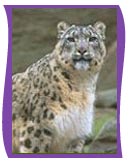|
|
 The snow leopard
(Panthera uncia) has a round head, broad paws and a long, round tail. Its paws have cushions of hair which prevent the cat from sinking into the snow and protect the soles of its feet from snow, the cold, rough ground in winter, and the sun-heated rocks of summer. The snow leopard
(Panthera uncia) has a round head, broad paws and a long, round tail. Its paws have cushions of hair which prevent the cat from sinking into the snow and protect the soles of its feet from snow, the cold, rough ground in winter, and the sun-heated rocks of summer.The snow leopard's beautiful coat changes from season to season. Its thick, white winter coat becomes a fine yellow-gray during the summer. Solid black or dark brown spots arranged in rows mark its head and lower limbs. This spotted white coat serves as a wonderful winter camouflage and helps to keep the cat warm in winter and cool in summer. Habitat and Distribution: Essentially adapted to mountain life, the snow leopard lives in remote areas of Asia's Himalayan Mountains. Depending upon the season, it occupies mountain steppes and coniferous forests at altitudes ranging from 5,900 to 18,000 feet, and contends with extremes of climate. Diet: Because of a low prey density, the snow leopard migrates to different altitudes along with its prey and usually hunts alone. During the summer, the snow leopard hunts at high altitudes for wild sheep, hare, mice and birds. In winter they hunt at the lower elevations for deer, wild boar, gazelles and hare. Reproduction: Cubs are born in well-hidden and fur-lined dens which the mother builds beneath rocks or in rocky crevices. One to four young are born in late spring or early summer. Like newborn kittens, they open their eyes only after a week or more, but by the time they are two months old, they are very active. They remain with their mother only through the first winter of their lives. Then they must forage for themselves. Behavior: Snow leopards are fantastic jumpers; they can leap 20 to 50 feet through the air. With no difficulty they can leap straight up into a tree or onto a cliff, often simply to perch and rest. The long, thick tail helps the snow leopard to keep its balance. Status: The snow leopard has become rare in many parts of its native habitat largely because it has been widely hunted for its strikingly beautiful coat. India has protected its populations since 1952, and World Wildlife Fund supports research and habitat conservation projects for the snow leopard in Nepal.
|